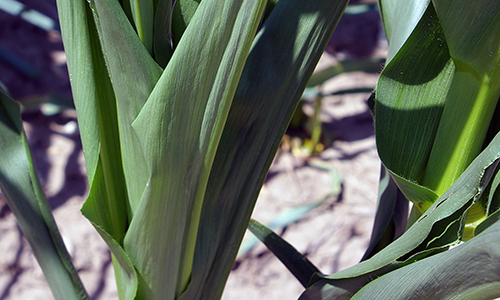Crops need rain and lower temperatures soon for relief. Most crops are “just a few days away from difficult times,” says University of Missouri Extension agronomy specialist Bill Wiebold.
“We can go from ‘not so bad’ to ‘pretty bad’ quickly,” Wiebold says.
Crops need up to 1-2.2 inches of rain weekly to grow well. In June, most areas of the state fell far behind.
Wiebold points to June rainfall amounts in different areas of the state. Atchison and Boone counties reported only 0.04 inch and only 0.12 inch fell in Knox County in northeastern Missouri in the first week of June. Carroll County received 0.58 inch of rain; Pemiscot got 1.4 inches and Barton had 1.66 inches. In the second week of June, only Barton County received rain, and it was a meager 0.32 inches.
Lack of rainfall and temperatures above 90 degrees in the second week of June raise concerns of a possible drought.
MU agronomists in much of the state report that corn plants are “rolling” with dwindling soil moisture and rising temperatures.
Corn leaves roll as a defense mechanism to protect against excessive moisture loss through transpiration. Rolling exposes less leaf surface to the sun’s heat. Lack of water during the time when ear size is developing can spell trouble. Smaller ears with fewer kernels mean lower yields.
Soybean, too, faces stress due to lack of rain. Late-planted soybeans lack time to develop strong root systems. Early rooting problems—whether due to cool weather, nutrient deficiencies or soil compaction—spell trouble for soybean if drought occurs, Wiebold says.

MU Extension climatologist Pat Guinan said the northeastern quadrant of Missouri faces “very dry” conditions. That area’s high-clay-content soil tends to be more vulnerable to water stress when a dry period emerges. “The forecast is not encouraging,” he says.
Guinan says May precipitation was below normal in the area and the recent hot spell hastened evaporative demand. Vegetation quickly went into stress mode. Also, a large part of the state, extending from northeastern through southwestern Missouri, reports precipitation deficits of 4-8 inches since Jan. 1.
Guinan encourages Missouri residents to submit drought impact reports to the National Drought Mitigation Center. Use the Drought Impact Reporter, http://droughtreporter.unl.edu, to submit reports. These reports provide local expertise to authors of the Drought Monitor map. Drought impact statements are seen by the Drought Monitor author and the general public.
“More participation and input from local Missourians will establish a consensus among folks and hopefully provide a more accurate portrayal of drought in the Show-Me State,” Guinan says.







